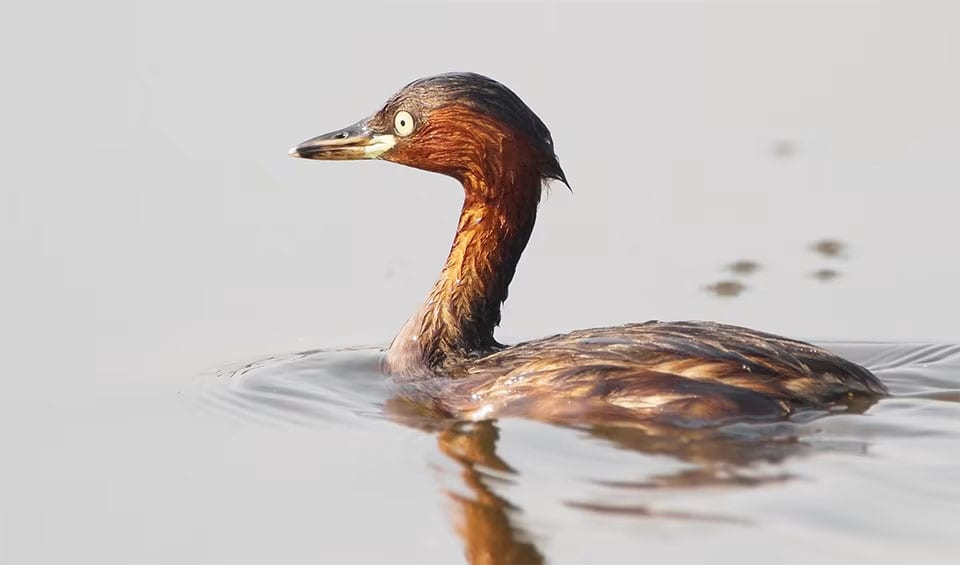A master of freshwater habitats and the smallest member of the grebe family in Europe. Its compact size and dexterous abilities in water distinguish it as a proficient hunter and an intriguing subject of avian study.
Adapted perfectly for an aquatic lifestyle, the Little Grebe, also known as the Dabchick, has a streamlined body that allows for exceptional maneuverability both on the surface and underwater. Its lobed feet, set back on the body, act like flippers to propel it through the water with agility and speed. This bird’s diving capability is central to its feeding strategy, enabling it to catch a variety of prey with remarkable efficiency.
The Little Grebe’s distribution is extensive, spanning across various continents. In Africa, it can be found in suitable habitats from the north to the south of the continent. It is widespread throughout Asia, reaching as far as New Guinea, and it occupies a significant range across Europe. This broad distribution is a testament to the species’ adaptability to different environmental conditions.
The diet of the Little Grebe is varied but predominantly consists of aquatic insects and their larvae, supplemented by small amphibians, crustaceans, mollusks, and fish. Their hunting technique involves diving and chasing prey underwater, often staying submerged for lengthy periods.
During the breeding season, Little Grebes become more territorial and are often seen and heard in smaller bodies of water. Their distinctive “whinnying” call is a common sound in their habitats during this time. Outside the mating season, they are more likely to be found in larger, open waters, including sheltered estuaries and occasionally beaches.
Distribution
 Afghanistan
Afghanistan Albania
Albania Algeria
Algeria Angola
Angola Armenia
Armenia Australia
Australia Austria
Austria Azerbaijan
Azerbaijan Bahrain
Bahrain Bangladesh
Bangladesh Belarus
Belarus Belgium
Belgium Benin
Benin Bhutan
Bhutan Bosnia And Herz.
Bosnia And Herz. Botswana
Botswana Brunei
Brunei Bulgaria
Bulgaria Burkina Faso
Burkina Faso Burundi
Burundi Cambodia
Cambodia Cameroon
Cameroon Central Af. Rep.
Central Af. Rep. Chad
Chad China
China Comoros
Comoros Congo-Brazzaville
Congo-Brazzaville Croatia
Croatia Cyprus
Cyprus Czechia
Czechia Côte D’ivoire
Côte D’ivoire DR Congo (Kinshasa)
DR Congo (Kinshasa) Denmark
Denmark Djibouti
Djibouti East Timor
East Timor Egypt
Egypt Equatorial Guinea
Equatorial Guinea Eritrea
Eritrea Estonia
Estonia Eswatini
Eswatini Ethiopia
Ethiopia Faroe Islands
Faroe Islands Finland
Finland France
France Gabon
Gabon Gambia
Gambia Georgia
Georgia Germany
Germany Ghana
Ghana Gibraltar
Gibraltar Greece
Greece Guinea
Guinea Hong Kong
Hong Kong Hungary
Hungary India
India Indonesia
Indonesia Iran
Iran Iraq
Iraq Ireland
Ireland Israel
Israel Italy
Italy Japan
Japan Jordan
Jordan Kazakhstan
Kazakhstan Kenya
Kenya Korea
Korea Kuwait
Kuwait Kyrgyzstan
Kyrgyzstan Laos
Laos Latvia
Latvia Lebanon
Lebanon Lesotho
Lesotho Liberia
Liberia Libya
Libya Liechtenstein
Liechtenstein Lithuania
Lithuania Luxembourg
Luxembourg Macao
Macao Madagascar
Madagascar Malawi
Malawi Malaysia
Malaysia Mali
Mali Malta
Malta Mauritania
Mauritania Mayotte
Mayotte Moldova
Moldova Monaco
Monaco Mongolia
Mongolia Montenegro
Montenegro Morocco
Morocco Mozambique
Mozambique Myanmar
Myanmar Namibia
Namibia Nepal
Nepal Netherlands
Netherlands Niger
Niger Nigeria
Nigeria North Korea
North Korea North Macedonia
North Macedonia Norway
Norway Oman
Oman Pakistan
Pakistan Papua New Guinea
Papua New Guinea Philippines
Philippines Poland
Poland Portugal
Portugal Qatar
Qatar Romania
Romania Russia
Russia Rwanda
Rwanda San Marino
San Marino Saudi Arabia
Saudi Arabia Senegal
Senegal Serbia
Serbia Sierra Leone
Sierra Leone Singapore
Singapore Slovakia
Slovakia Slovenia
Slovenia Somalia
Somalia South Africa
South Africa South Sudan
South Sudan Spain
Spain Sri Lanka
Sri Lanka Sudan
Sudan Sweden
Sweden Switzerland
Switzerland Syria
Syria Taiwan
Taiwan Tajikistan
Tajikistan Tanzania
Tanzania Thailand
Thailand Togo
Togo Tunisia
Tunisia Turkey
Turkey Turkmenistan
Turkmenistan UAE
UAE Uganda
Uganda Ukraine
Ukraine United Kingdom
United Kingdom Uzbekistan
Uzbekistan Vietnam
Vietnam Yemen
Yemen Zambia
Zambia Zimbabwe
ZimbabweAnything we've missed?
Help us improve this page by suggesting edits. Glory never dies!
Suggest an editGet to know me
Terrestrial / Aquatic
Altricial / Precocial
Polygamous / Monogamous
Dimorphic (size) / Monomorphic
Active: Diurnal / Nocturnal
Social behavior: Solitary / Pack / Herd
Diet: Carnivore / Herbivore / Omnivore / Piscivorous / Insectivore
Migratory: Yes / No
Domesticated: Yes / No
Dangerous: Yes / No




